Healthy and nutritious soil is a prerequisite for growing a bountiful harvest in your vegetable and fruit garden. Your garden soil has a direct impact on how well your garden vegetables will grow. Amending your soil will be required to keep your soil fertile and healthy. In this post, I cover 62 top dry soil amendments to that you can use to improve the garden.
Whether your soil is to be used in a conventional in-ground row garden, raised garden beds, or in containers, your garden soil often has to take a different path to enable great soil health.
You will need to amend your garden with dry soil amendments to get your garden soil in an optimal condition. This will need to happen as you establish a new garden or when you need to add nutrients back in, after a season or year of growing vegetables in the garden.
Therefore, understand soil properties, and what makes up good soil, and then you can identify the various amendments that may be a benefit to your soil. This ensures you set yourself up right to have a successful garden and a bountiful harvest.
Desired Soil Properties for Successful Gardening
Soil can take on many characteristics and attributes so let’s first discuss what our desired soil properties are and why are they important.
Friable and Loose
You want your soil to be friable and loose. Good friable soil is soil that has a crumbly texture and is easy to break up. Friable soil is characterized by mostly fine aggregates with no significant clotting.
Friable and loose soil is important as it allows for good drainage and root growth. Clotted-up soil also doesn’t help facilitate plant respiration at the root level which is critical to its growth. Plant respiration is a process that involves taking in oxygen and releasing it as carbon dioxide into the atmosphere.
Therefore choosing the right soil components and amendments into a soil mix helps facilitate your soil staying loose and friable resulting in a bountiful harvest.
Organic matter such as compost, leaf mulch, humus, and composted manure are all good amendments to help your soil stay loose and friable. Vermiculite and perlite will also help you soil stay loose and friable.
Bonus: Raised Bed Gardens give you the benefit of not having to walk where your plants are along with the need to till the soil. Compression of the soil from walking makes your soil clumped and non-friable, while tilling will free up your soil, it results in a killing off of our garden friends, earthworms.
Fertile Soil
Work a variety of composted organic material into you soil to get your soil fertile as it can be. You will want to amend your soil as well with organic material each garden season or at least annually to recharge your soil with nutrients and micro-nutrients that your plants used up or depleted from the soil.
Fertile soil is soil that contains all the major nutrients for plant nutrition, plus other nutrients needed in smaller quantities. Consider send a soil sample in to your local extension services if you wish to know just how fertile your soil is.
Soil amendments to increase nutrients and minerals in your soil include composted cow manure or any compost at that. Amending any of the various “meals” like Crab Meal, Bone Meal, etc., will provide an addition of nutrients. Just make sure you understand what they are providing and if that is the best amendment for your garden application. You may also wish to add some Azomite Rock Dust or greensand to supplement your micro-nutrients and mineral content.
If your plants need some nutrition after they are growing, you can apply a touch of organic fertilizers such as liquid seaweed extract, molasses, among other organic supplements.
Avoid using synthetic fertilizers to stay organic and to avoid a build-up of chemicals and environmental run-off. They also tend to deplete soils of natural microorganisms and nutrients by overstimulating microorganism growth in the soil.
Bonus: Make sure you understand your soil’s needs and what the dry soil amendments will add to your soil. For instance, the many “meal” amendments provides a variety of NPK (Nitrogen, Phosphorous, Potassium) levels. For instance, Crab Meal has an NPK of 4-3-0. Blood Meal has an NPK of 12-0-0. Seabird Guano has an NPK of 0-11-0.
All three of these “meal” amendments will have a significantly different influence on your plants. The Nitrogen-rich Blood Meal provides a big boost to speed up the growth of leaves and stems, which may be advantageous for leafy vegetables. Whereas, Phosphorous-rich fertilizers help vegetable plants with their root development, stem formation, and fruiting in vegetables like tomatoes, peppers, and squash. Phosphorus is also needed for seed formation and flowering.
Therefore, make sure you the soil amendment you choose fits the right needs of the garden and the plants within that garden!
Good soil texture, structure, and porosity
Good soil structure is soft and crumbly, with granular aggregates that hold together, but not clot together excessively in water. Well-structured topsoil has small, rounded aggregates and a range of pore shapes and sizes that form a continuous network. This allows good aeration, root proliferation, and better drainage.
The ideal soil texture is a mix of sand, silt, and clay particles, known as a loam. Soil texture is important to overall soil and plant health as it relates to soil porosity. Soil porosity refers to the pore spaces where air and water reside. Porosity depends on both soil texture and structure.
Earthworms improve soil structure and porosity by tunneling and mixing up the soil. Their tunnels provide larger pores that allow water and gases to flow into the soil. They also increase the amount of air and water that gets into the soil leading to exceptional root growth. With that in mind, avoid tilling and how deep you work in your soil amendments to limit damage to your earthworm population.
Water Retention/Drainage
Your soil’s ability to retain water while also allowing excess water to drain is a key component of your soil.
Soil water retention refers to how well the soil can hold water. It’s ability to retain water is related to the soil’s particle size. Water molecules hold more tightly to the fine particles of a clay soil than to coarser particles of a sandy soil. Clays generally retain more water which is not too surprising.
You can improve the water retention properties of your soil by adding vermiculite, sphagnum (peat) moss, and/or coconut coir. You can also improve the drainage by adding perlite and sand to your soil.
Organic material, such as coconut coir, peat moss, or even compost, will absorb water, retaining moisture that plants can use during dry spells. Organic material also improves the structure, aeration and overall health of the soil.
Another key amendment to soil that aids in water retention is leaf or other organic mulch. Organic mulch insulates the top layer of the soil from the environmental conditions like temperature, wind, and humidity. Moisture will not evaporate as fast with a thick organic mulch sitting on top of the soi.
Understand your Soil
At it’s most basic definition, Soil is a mixture of weathered rock fragments and organic matter at the earth’s surface. It is biologically active – a home to countless microorganisms, invertebrates, and plant roots. Native soil is roughly 50% pore space. This space forms a complex network of pores of varying sizes, much like those in a sponge.
Soil provides nutrients, water, and physical support for plants as well as oxygen for plant roots. Organisms in the soil are nature’s primary recyclers, turning dead cells and tissue into nutrients, energy, carbon dioxide and water to fuel new life.
Soil Types
Soil is classified into various soil types including Clay, Sand, Silt, Loam and Chalky. the difference between each type is the size of the soil particles creating a different texture, water retaining abilities, nutrients, minerals, and of course, pH.
Clay
Clay soil is a type of soil made up of very fine mineral particles and not much organic material. The particles are densely packed with little or no airspace. This makes the soil sticky and not well-drained. Clay soil is not suitable for growing plants because it is harder for moisture and air to penetrate the soil.
Clay soil can hold a lot of nutrients and water due to the capillary action between the clay particles. However, it takes a little bit longer to drain.
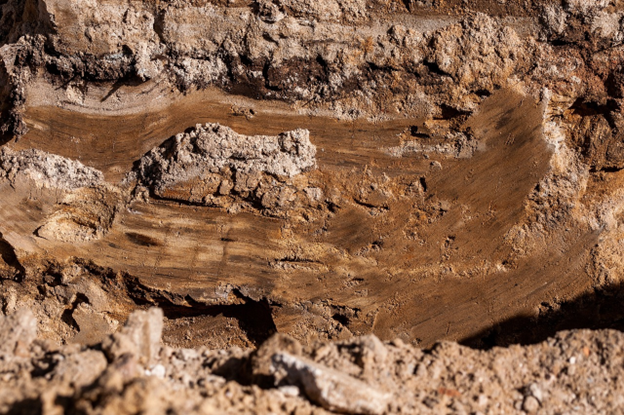
Sand
Sandy soil is a type of soil that is made up of small particles from weathered rock. Soil full of sand is gritty and light-colored because it lacks humus, the dark-colored organic material in soil that delivers nutrients to plants.
Sandy soil has a high sand content. It drains quickly and is easy to work with but can dry out in warm weather. Sandy soil also warms up more quickly in spring than clay soil.
Sandy soil is known as the poorest type of soil for agriculture and growing plants as they have very low nutritional value and poor water-holding capacity. However, some plants, such as irises, lavender, rosemary, and succulents, prefer sandy soil.
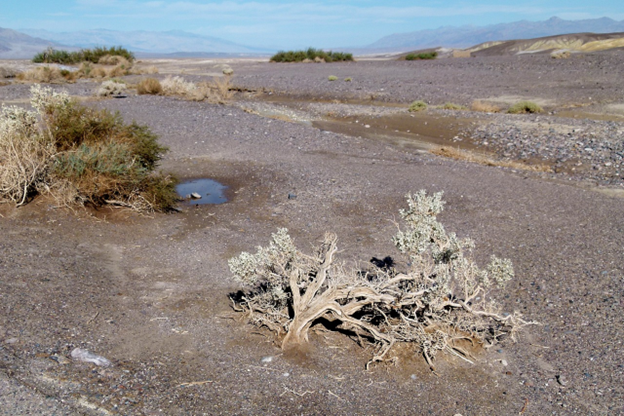
Silt
Silt is a soil type that is made up of granular material that is a size between sand and clay. The Silt soil type is composed mostly of broken grains of quartz. Silt can occur as soil, often mixed with sand or clay, or as sediment mixed in suspension with water.
Silt has a floury feel when dry and lacks plasticity when wet.
It is a light and moisture-retentive soil type with a high fertility rating. Silt soils are well-drained and hold moisture well. However, because the particles are fine, they can be easily compacted and are prone to washing away with rain.
Silt is created when rock is eroded, or worn away, by water and ice. Silt is easily transported in water and is fine enough to be carried long distances by air as “dust”.
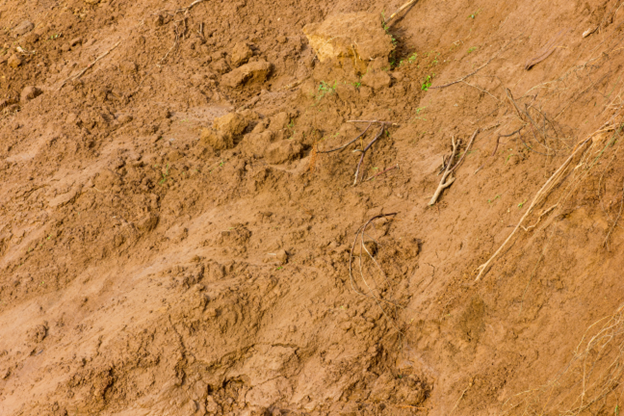
Loam
Loam is a mixture of sand, silt, and clay soil that contains additional organic matter. It is a sub-category of topsoil, but topsoil is not always loam. A medium loam is made up of 40% sand, 40% silt, and 20% clay.
Loam is fertile, well-drained, and easy to work. It is well-suited for cultivation because plant roots receive enough water and nutrients for growth and development. Most garden plants prefer loam.
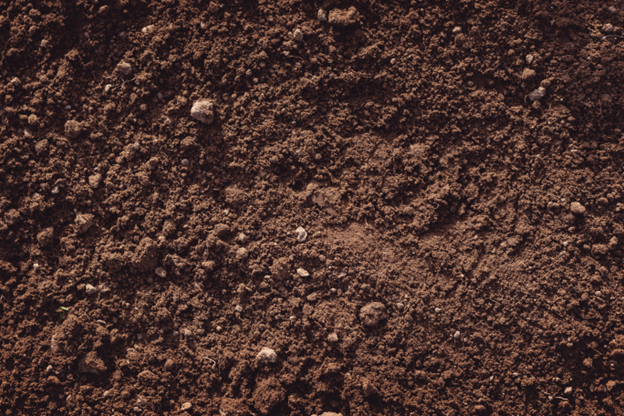
Chalky
Chalky soil is a type of alkaline soil that comes from chalk or limestone. It can vary in structure from heavy to light and can be solid, gravelly, or clay.
Chalky soil is calcium carbonate from sediment that has built up over time. It is usually shallow and stony, and dries out quickly.
Chalky soil has a pH of 7.1 and higher. It is free draining, able to hold only a little water, and easily dries out. Chalky soil tends to warm up quickly in spring and is very dry in summer.
Utilize chalky soil for plants that can tolerate alkaline conditions, such as bulbs, tubers, and flowering shrubs.
Soil pH
What is pH?
The pH describes the relative acidity or alkalinity on a scale from 0 to 14, with 0 being most acidic, 14 being most alkaline or basic, and 7 being neutral. This measure demonstrates the concentration of reactive ions (H+).

The measurement was originally used by the Danish biochemist S.P.L. Sørensen to represent the hydrogen ions concentration, expressed in equivalents per liter, of an aqueous solution: pH = −log[H+] (in expressions of this kind, enclosure of a chemical symbol within square brackets denotes that the concentration of the symbolized species is the quantity being considered). This sounds all complicated. Let’s break it down to what we need to know.
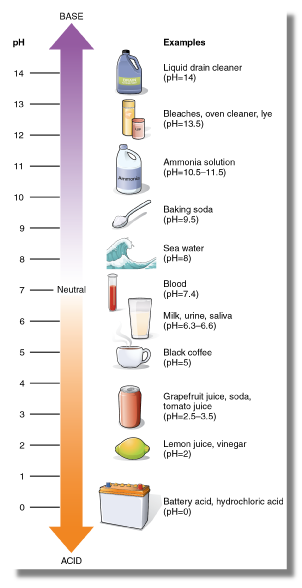
Most food crops prefer a pH of 5.5 to 7.0 but can still have productive plants even outside of this standard pH ranges. A few examples of plants that prefer pH outside of the range defined above include:
- Asparagus: Asparagus like alkaline soil conditions (high pH)
- Blueberries: They like more acidic soil (low pH)
- Potatoes: Potatoes prefer a more acidic soil (low pH)
The pH of Soil
Your soil’s pH level is a result of interactions among rock, plants, and weather conditions over many years. This varies with climate and regional geography, along with local specifics. Soil pH is a key variable in soils as it affects the chemical processes that allow the converting and availability of vital nutrients in the soil to the plant. It does this by controlling the chemical structure of the essential nutrients. Plant growth is controlled by the pH interaction within the soil.
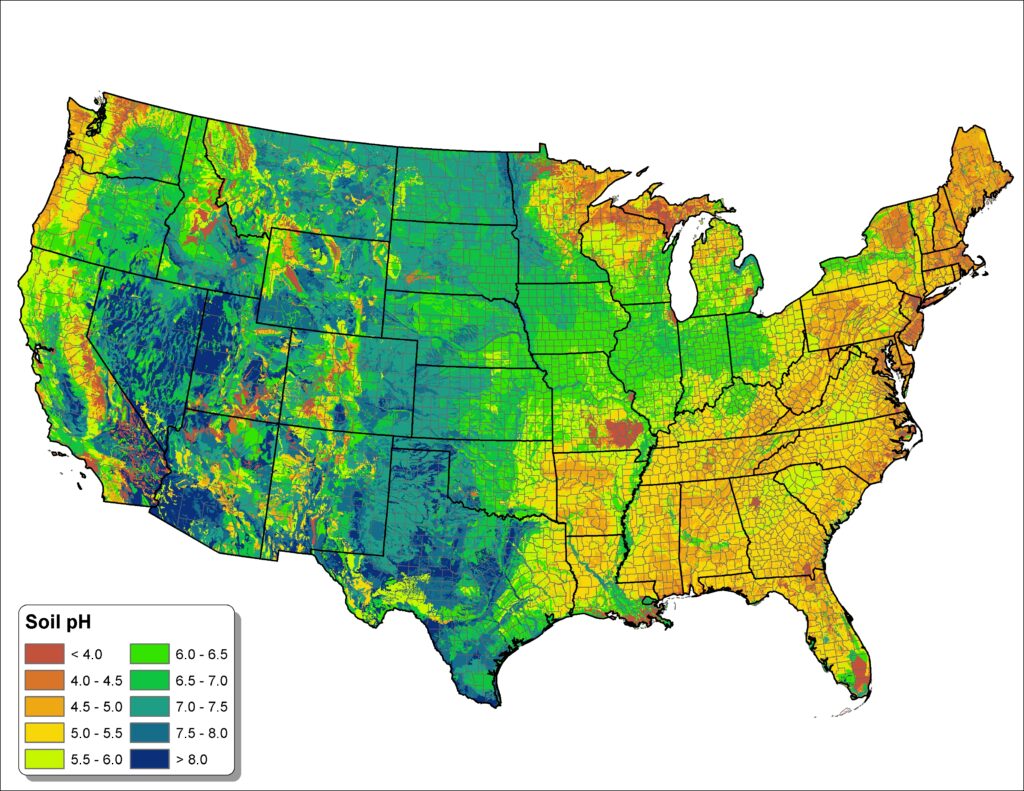
It’s also important, especially for those concerned about your health and staying organic, those synthetic fertilizers, especially those high in ammonium or sulfur, can make soil more acidic. Acid rain can contribute to pH over time. Organic material, including sphagnum peat moss and pine needles, will naturally acidify a bit over time during decomposition. Organic fertilizers can also increase pH over time but at a slower rate.
Soil Tests
There are several ways to determine your in-ground soil pH with varying levels of preciseness.
Soil Testing kits are available from Amazon and your local plant nurseries. Some kits give a broad pH reading by using litmus paper and matching the color of the exposed paper with a chart. Other DIY kits are not complicated and involve placing a soil sample in a bag and adding a supplied reactant to the soil solution, and the resultant color indicates the pH.
There are also pH meters that you can place in the soil and it will give you a reading. The pH meter comes with other features such as moisture, light and nutrient level indications. This method gives you a much better level of accuracy.
The best way to really know your soil pH is by sending in soil samples to soil testing labs done through extension services, such as that provided by the LSUAgCenter’s Soil Testing and Plant Analysis Lab. The nice result of using a service like this is that they give you accurate pH readings and specific recommendations as to how to amend your soil to get to a specific pH range.
New Garden Soil
In-Ground Gardens
In-ground garden soil, which typically starts out from the existing topsoil, often need amendments to make the soil more friable, nutritious, and able to retain water while also allowing the excess water to drain. Work the soil amendment each and every season to build the soil up to what it needs to be successful.
I started with in-ground rows in my back yard. I had to till it and work the soil for numerous years but still didn’t get the soil where I wanted it to be at. My backyard is clay within an inch or two of the grass surfaces, so it is rough going.
Raised Bed Gardens and Containers
I now focus mostly on raised bed gardening with a few containers as well. The beauty of this kind of gardening is that you typically start-out with good soil. You can buy potting mix or mix mine up like I do with sphagnum peat moss, course vermiculite and a blend of 3-5 different kinds of composts, along with some Azomite Rock Dust.
Amending the Soil
Regardless of garden type, the soil must be amended season to season as nutrients and minerals are depleted from the plants that are grown.
Volume of the soil also tends to decrease due to settling but also when you pull plants and their roots from the garden when cleaning out old plants.
There are both dry and wet amendments we can apply to our garden beds. Wet amendments include compost tea, organic root stimulator, organic fish and kelp fertilizer, etc. For this article, I am focused on 62 top dry soil amendments to that you can use to improve the garden.
How to Establish Cubic Feet of Amendment Needed?
The necessary amounts of dry soil amendments to your soil will need to be determined based on your specific soil requirements and how you want to amend it. However, one good thing to know is how the determine cubic feet, and not square feet, of amendment needed. Each bag of dry soil amendments comes in various sizes such as 1 cubic foot for compost, or 3.8 cubic feet for sphagnum peat moss.
For example, if I intend to amend my raised bed garden with some compost as it’s settled down over the last few years. Assume each bag of compost is 1 cubic foot. Also, assume I want to add 3 inches of compost to my 5 ft by 4 ft raised bed. To determine cubic feet needed, I would multiply length by width by height. So, in the example:
5 ft x 4 ft x (3”/12”) ft = 5.0 cubic feet
In this example, you would need to purchase 5 bags of compost at a minimum.
Dry Soil Amendments
The following provides a listing and a description for all the various dry soil amendments that can be applied to your garden. This list will cover the 62 top dry soil amendments to improve the garden.
(1) Alfalfa Meal
Alfalfa Meal is an organic source of nutrients from dried alfalfa plants. It contains nitrogen, phosphorus, potassium, and other beneficial trace elements.
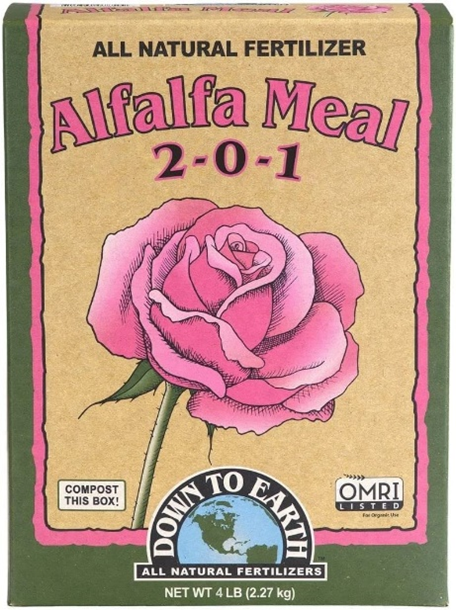
(2) Ammonium Sulfate/Elemental Sulfur
Soil pH can be reduced effectively by amending your soil with aluminum sulfate or elemental sulfur. Each amendment provides varying speeds to lower the soil’s pH. For example, Aluminum Sulfate is faster acting than elemental sulfur as it’s much more soluble. The advantage of elemental sulfur is that it’s less expensive, particularly if a large area needs to be treated.
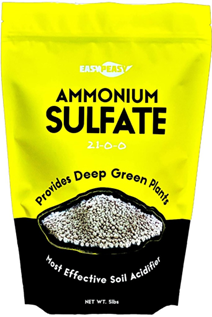
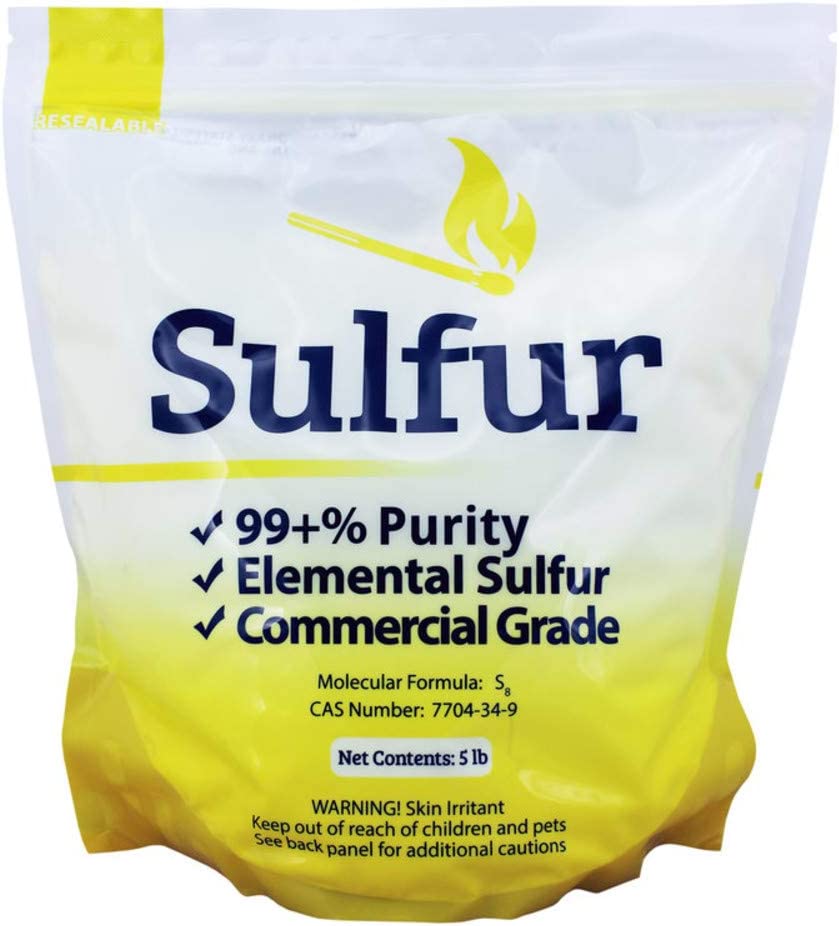
Sulfuric acid is another amendment but only utilized by commercial operations due to it’s potential danger in using it.
(3) Ammonium Nitrate
Ammonium Nitrate, and other Ammonium-based fertilizers like Ammonium Sulfate, are convenient to use as they not only fertilize your soil but can also acidify the soil. However, you would only want to apply so that it makes gradual changes to the soil pH. Still, there is much less risk of lowering pH too much when using Ammonium Nitrate than using elemental sulfur. Ammonium Nitrate can also be used with acid-loving plants to maintain an already low soil pH.
(4) Aragonite
Aragonite is a great source of calcium made from seashells that have been broken down over time by the ocean. This creates a more layered structure than that of stone. This layered structure facilitates more surface area available than traditional limes, which are pulverized rock and take longer to breakdown.
Aragonite is very bio available to your plants since it comes from seashells. It quickly neutralizes, conditions, and balances your soil. Use Aragonite anytime throughout the year if your plants need calcium. Aragonite may also be used to offset a high magnesium content soil.
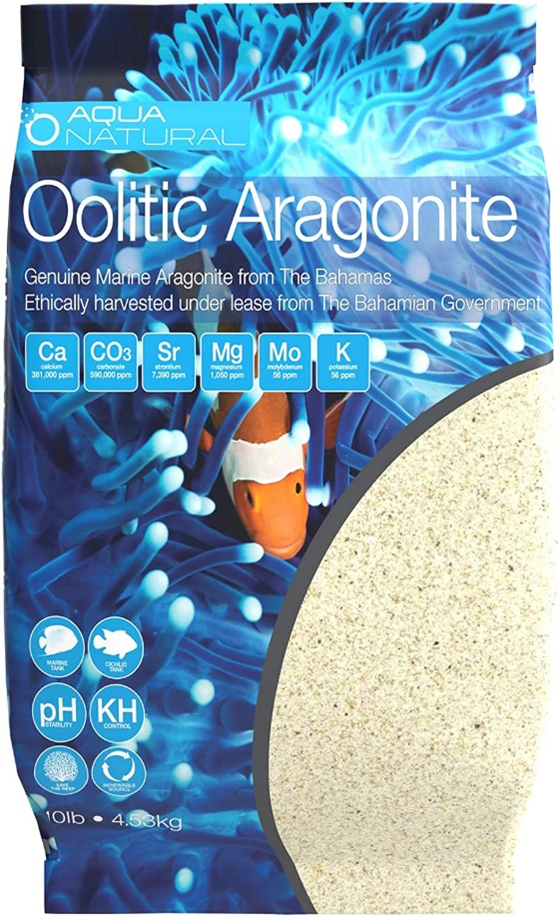
(5) Azomite (Rock Dust)
Azomite rock dust is a natural volcanic powder contained various trace minerals and other micro-nutrients. Azomite enhances soil fertility and plant nutrition. Its primary benefit is providing micro-nutrients needs for plant growth.
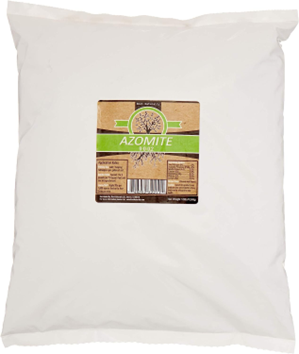
(6) Basalt Rock Dust
Basalt Rock Dust is mined from ancient volcanic deposits that is a source of natural minerals and trace elements that plants need to thrive. This product can be used on farms, home gardens, landscapes and turf, for a full range of plant types.
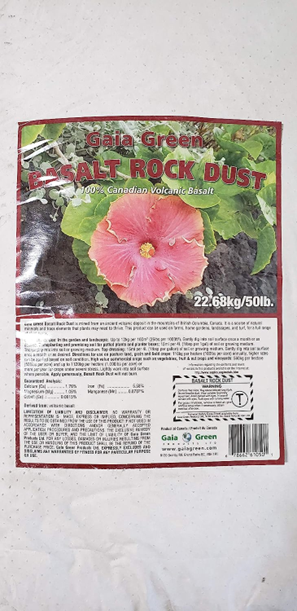
(7) Bat Guano
Bat Guano is a fertilizer derived from bat excrement that is rich in nitrogen, phosphorus, and potassium. It promotes plant growth and flowering.
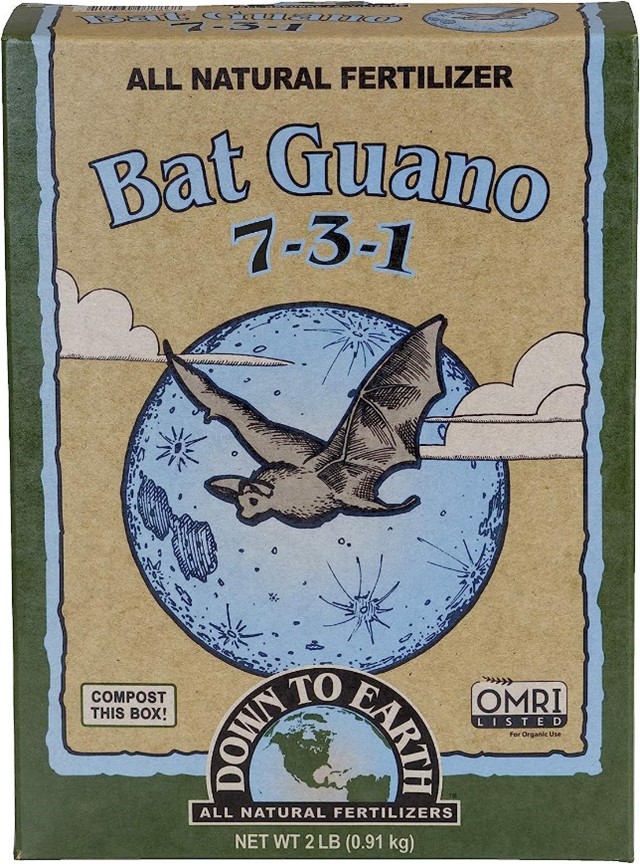
(8) Bentonite Clay
Bentonite clay is a great amendment to soil and compost thanks to its mineral content, ability to retain water, and dry to a hardened surface to help protect against boring pests. For sandy soil, use bentonite clay to help your soil retain water and nutrients better. It can also be amended to compost where it binds to beneficial organic matter and helps it stick around longer.
Also, as mentioned above, you can use it to create a protective barrier on plant surfaces, like the base of the stem on squash to protect against squash vine borer.
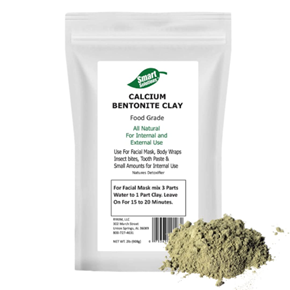
(9) Biochar
Biochar is a charcoal-like substance produced from charring organic matter. It is used to enhance soil fertility, water retention, and microbial activity. The charcoal-like byproduct is highly porous and completely safe for the environment. It offers long-term amendments that include resistance to decomposition, beneficial nutrient bioavailability in soil, soil water retention and reduction of nutrient runoff.
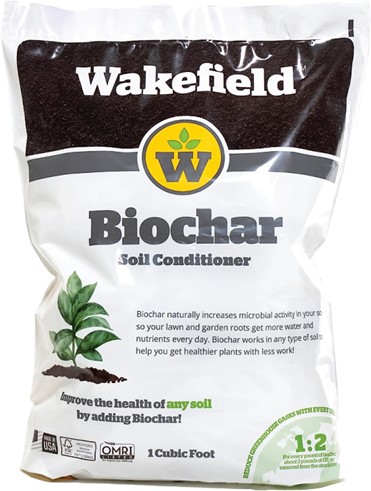
(10) Blood Meal
Blood meal is a nitrogen-rich soil amendment made from dried animal blood. It provides a quick-release source of nitrogen, which is vital for plant growth and leaf development. Blood meal is often used as a soil amendment for nitrogen-deficient soils or to promote lush foliage.
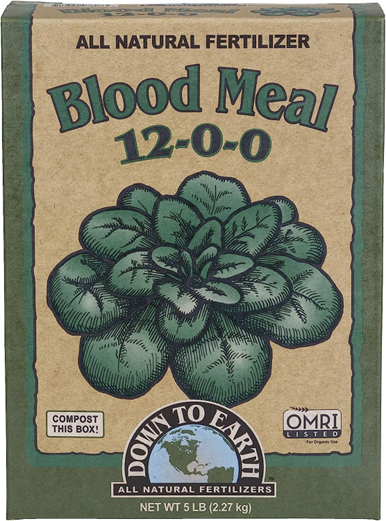
(11) Bone Char
Bone Char is calcined (kilned) bone meal used primarily for water purification and refining sugar. Bone Char 0-16-0 contains more than 16% available phosphate (P2O5) and 32% total phosphate plus 33-34 percent calcium. It is OMRI listed and can be applied without restriction on certified organic farmland. Bone Char 0-16-0 is currently less expensive than phosphate rock and significantly less is needed per acre to supply the same amount of available phosphate. The consistency is fine like table salt.
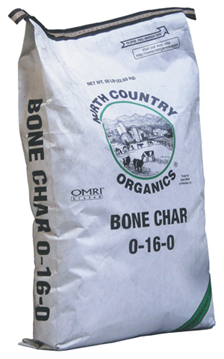
(12) Bone Meal
Bone Meal is a slow-release phosphorus amendment that is derived from ground animal bones. It promotes root development and flowering in plants. Bone meal is particularly beneficial for plants that require additional phosphorus, such as flowering bulbs and root crops.
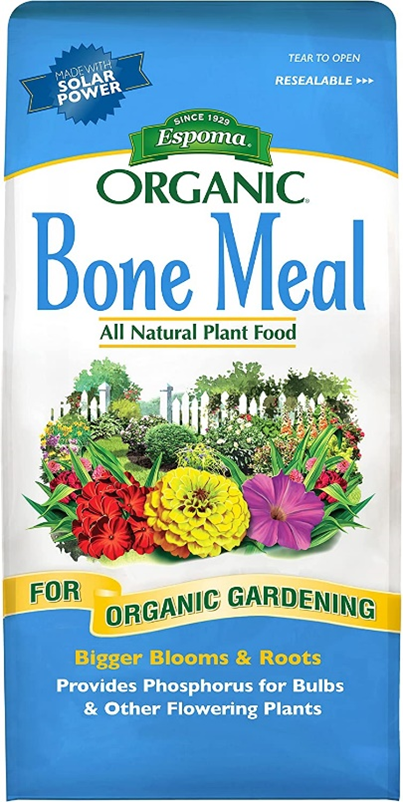
(13) Coco Coir
Coco Coir is a formal name for the fibrous material that is broken down from the out husk of coconuts. It does a good job with retaining water so as an amendment helps the soil retain water and nutrients. It is a great amendment for sand which lacks the above. The pH of Coco Coir ranges from 5.8 to 6.5.
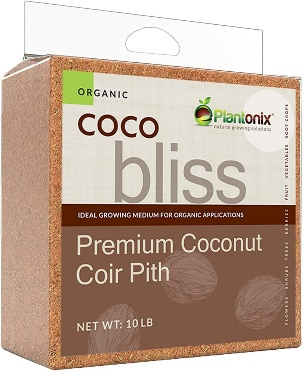
(14) Coffee Grounds
The use of coffee grounds as a soil amendment is a great way to supplement your soil with some carbon, nitrogen enrichment and organic matter that feed soil organisms. This is especially useful since it’s considered a waste product of making your coffee. What a great way to be sustainable in a way that will benefit your soil.
As a note, used coffee grounds are beneficial to your soil. However, they have not been shown to consistently lower soil pH. Use coffee grounds in your soil with a bit of discretion as it should not replace your compost or other organic elements in your soil.
(15) Colloidal Phosphate (Calphos) or Rock Phosphate
Colloidal Phosphate or Calphos is a natural, untreated soft phosphate that contains colloidal clay and phosphorus. It’s a rich organic source of colloidal phosphate and calcium that delivers a combination of readily available and slow-release nutrients.
Calphos comes from phosphate rock mined in Florida, which was formed millions of years ago from the mineralized remains of marine creatures. It’s non-toxic, non-corrosive, and provides all of the benefits of calcium and phosphorous without the handling problems.
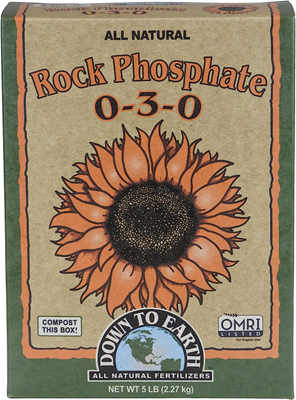
(16) Compost
Compost’s pH scale varies as it breaks down and matures. In the early stages, the pH is around 5.5 due to low-temperature microbes breaking the organic matter into amino acids. As the compost matures, bacteria known as mesophiles take over and bring the pH up to a more neutral level, between 6 and 8. With that in mind, adding compost to the soil effectively moves the pH toward neutral.
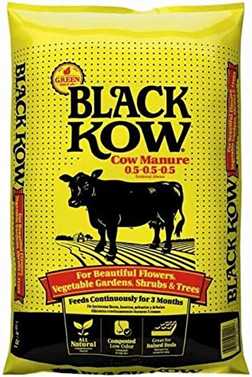
(17) Corn Gluten Meal
Corn gluten is a byproduct of corn processing that contains high levels of protein. It is not the same as cornmeal, which is ground corn. Corn gluten is the principal protein of corn endosperm, which is where the plant will grow out of the seed. It has historically been used as an animal feed. It is also often used as a natural fertilizer. As a weed suppressant, corn gluten acts as a natural “pre-emergent” – it inhibits seed germination by drying out a seed as soon as it cracks open to sprout.
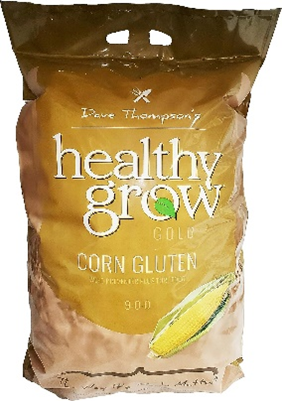
(18) Cottonseed Meal
Cottonseed Meal is an organic fertilizer that lowers the pH of soil, poses little danger of burning plants, and provides a great source of nitrogen, phosphorous, and potassium, and additional micro-nutrients. It provides high-nitrogen content (6-2-2) that makes a great organic amendment to your vegetable garden soil.
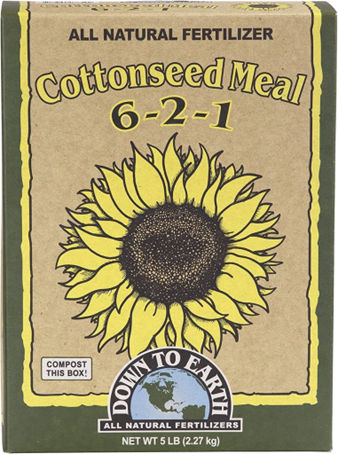
(19) Crab Meal
Crab meal is an organic fertilizer made from ground crab shells. It provides slow-release nitrogen, calcium, and chitin, promoting healthy plant growth.
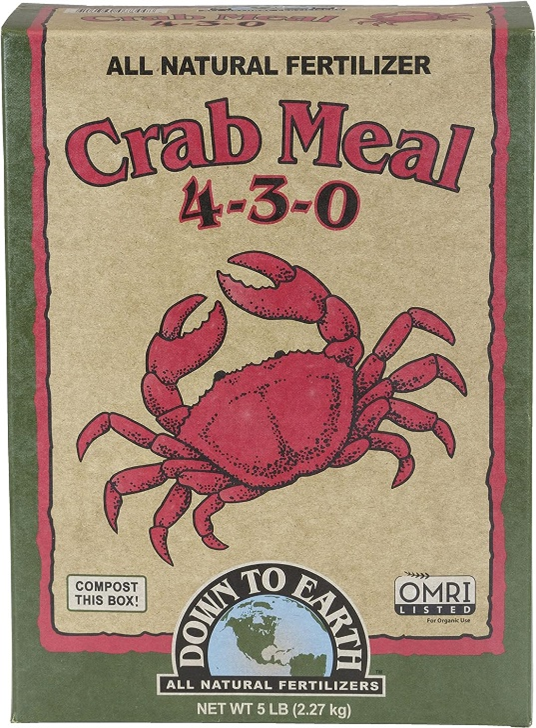
(20) Crushed Oyster Shells
Crushed oyster shells are a natural fertilizer that can be used as an alternative liming material to restore the soil’s chemical and microbial properties. They can also be used as a soil additive, mulch, or in compost.
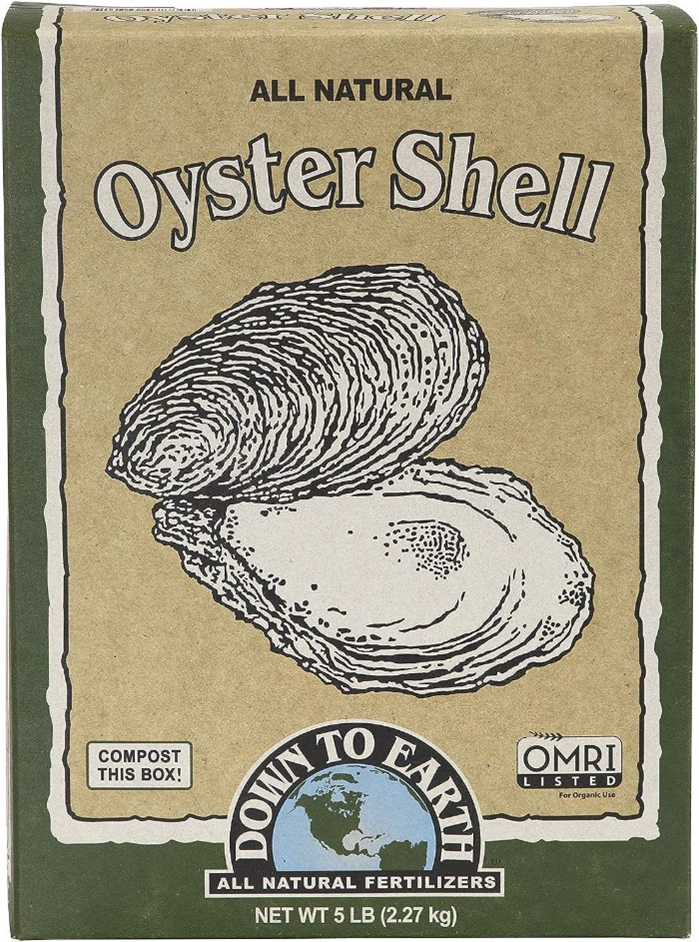
(21) Crustacean Meal
Crustacean meal is an organic fertilizer made from the shells of crustaceans like crabs and shrimp. It contains slow-release nitrogen and amino acids, and is also a good source of calcium, phosphorous, and magnesium.
Crustacean meal can be used as a soil amendment to promote plant health and defense. It can also be added to compost to help break down microorganisms and create a faster, more robust compost.
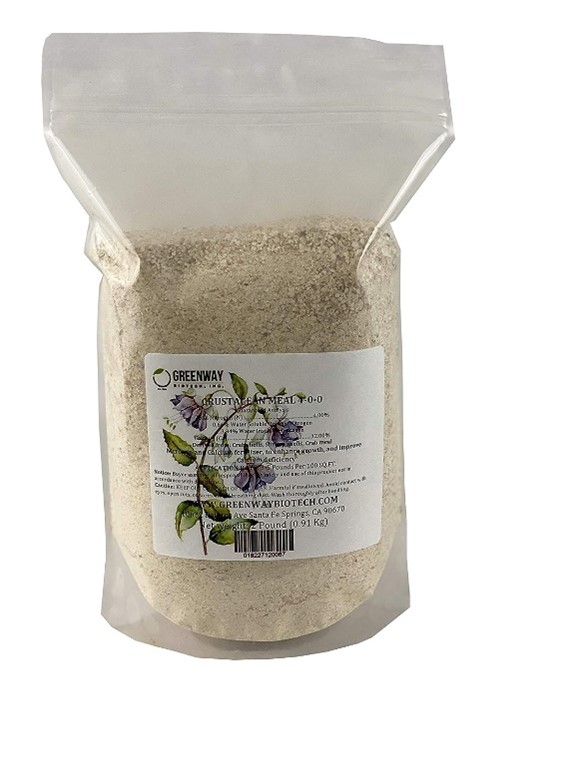
(22) Diatomaceous Earth
Diatomaceous earth (DE) is a powder made from the fossilized remains of microscopic, single-celled aquatic organisms called diatoms. The skeletons of these organisms are made of silica, a natural substance that makes up 26% of the Earth’s crust by weight. The microscopic pieces of DE are razor-sharp and can cut the exoskeletons of insects, killing them by dehydration. DE is effective against any insect with an exoskeleton, including fleas, mites, lice, ants, and more. Caution for use in gardens is suggested as DE can kill the beneficial bugs just as easily as the bad bugs.
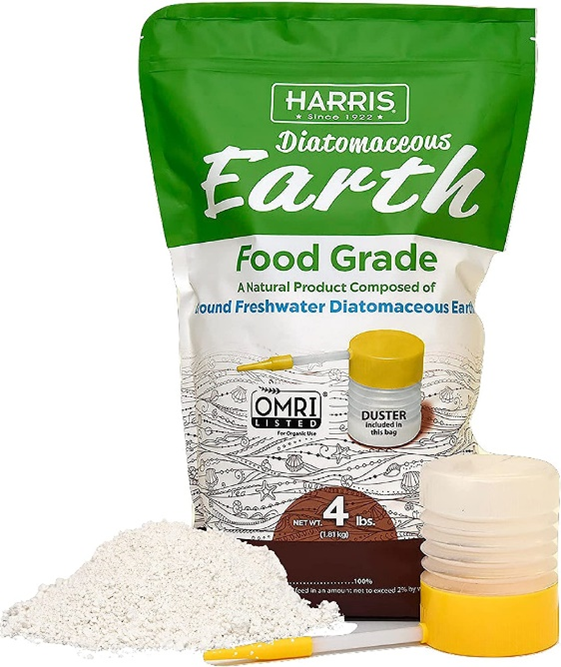
(23) Dolomite Limestone
Dolomitic Lime contains both Magnesium Carbonate and Calcium Carbonate. The ratio is typically 50% Calcium Carbonate and 40% Magnesium Carbonate, with 10% in additional materials. Dolomite Lime is typically amended to soil to reduce soil acidity (increase soil pH), which improves soil health.
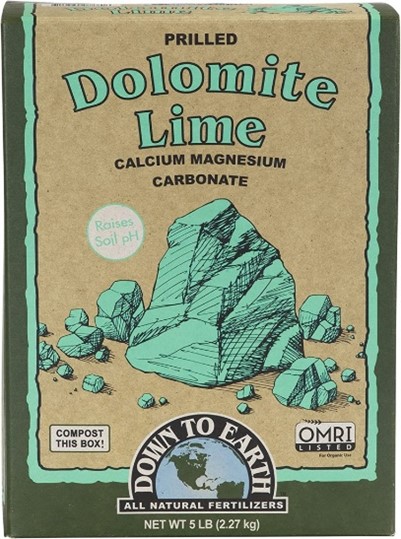
(24) Dried Molasses
Dried molasses is a natural sweetener extracted from sugar cane during the production of refined sugar. It can be used as a soil building product to stimulate microbes in soil, which can help make soil more fertile. Dried molasses can also help drive out fire ants
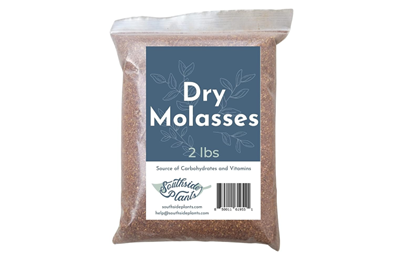
(25) Feather Meal
Feather meal is an organic, high-nitrogen fertilizer that can be used in gardens. It’s made from ground and hydrolyzed poultry feathers and contains up to 12% nitrogen. Feather meal is a slow-release fertilizer that can be used to improve soil structure, increase green leaf growth, and activate compost decomposition.
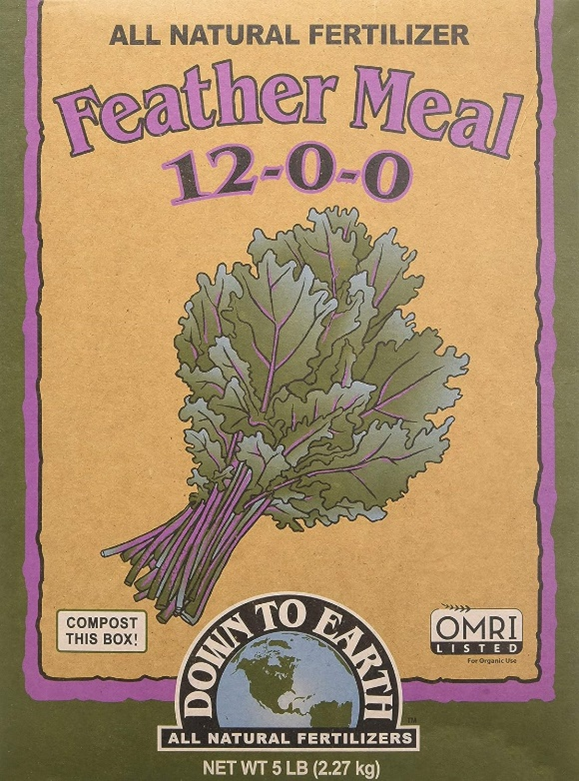
(26) Fish Bone Meal
Fish bone meal is a natural fertilizer made from dehydrated and ground fish bones. It’s an excellent source of phosphorus, calcium, nitrogen, and other essential minerals. Fish bone meal can benefit plants in all stages of growth, but is especially beneficial for roots, buds, and blooms. It’s also a good choice for supporting root and flower development.
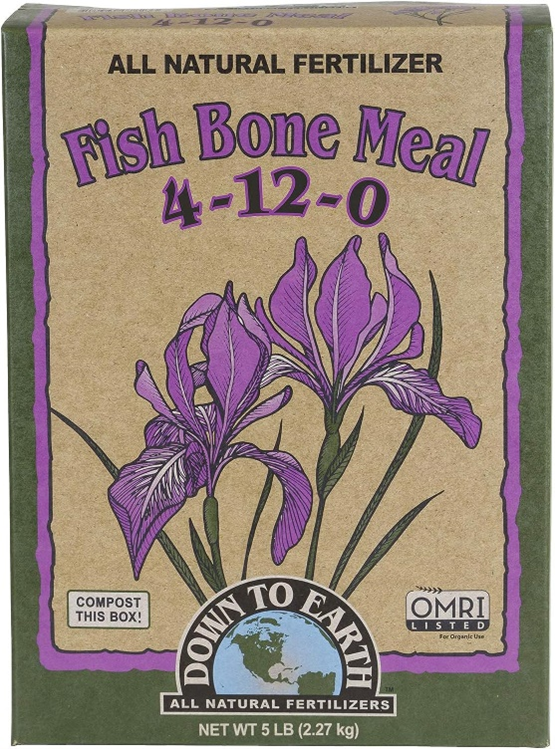
(27) Fish Meal
Fish meal is a nutrient-rich soil amendment made from ground dried fish. It is an excellent source of nitrogen, phosphorus, and trace minerals. Fish meal improves soil fertility and promotes vigorous plant growth. It is commonly used in organic gardening and farming.
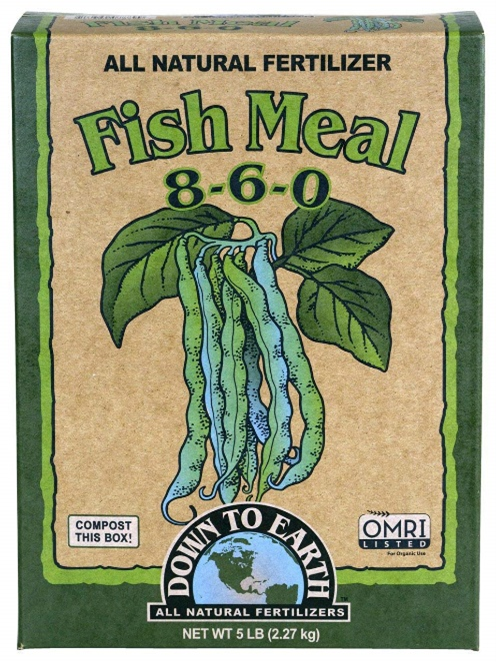
(28) Grass Clippings
Grass clippings can be used as mulch in garden beds to enhance soil quality and preserve moisture. They can also be mixed into the soil to add nitrogen and other nutrients. Grass clippings can be added to a compost pile along with other plant materials and soil to enrich your compostable materials.
(29) Greensand
Greensand is an organic mined mineral amendment rich in potassium, iron, and other trace minerals. It loosens up clay soils, binds sandy soils, and overall improves soil structure and nutrient availability. It is rich in the soil conditioning element Glauconite making it a great soil conditioner for flower beds, gardens, and lawn.
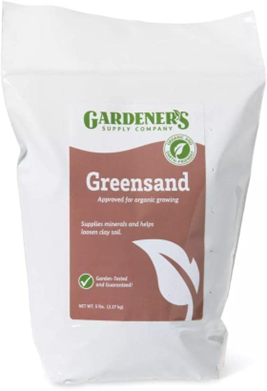
(30) Gypsum
Gypsum is a calcium sulfate compound used to amend soil with high clay content. It helps break up compacted clay soils, improving drainage and aeration. Gypsum also enhances the availability of nutrients in the soil.
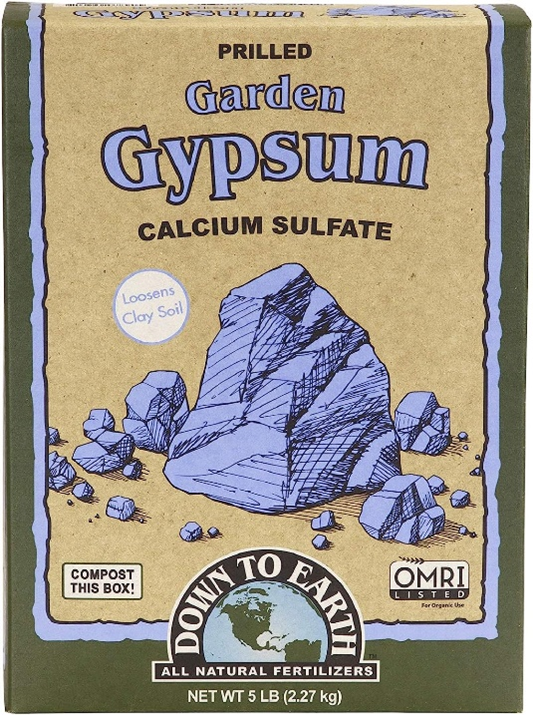
(31) Humic Acid
Humic acid is a natural soil conditioner that acts as an organic chelator and microbial stimulator. It has a unique carbon matrix which includes a high concentration of trace minerals and organic acids. Humic acid enhances the plant’s ability to take in essential nutrients and improves soil structure.
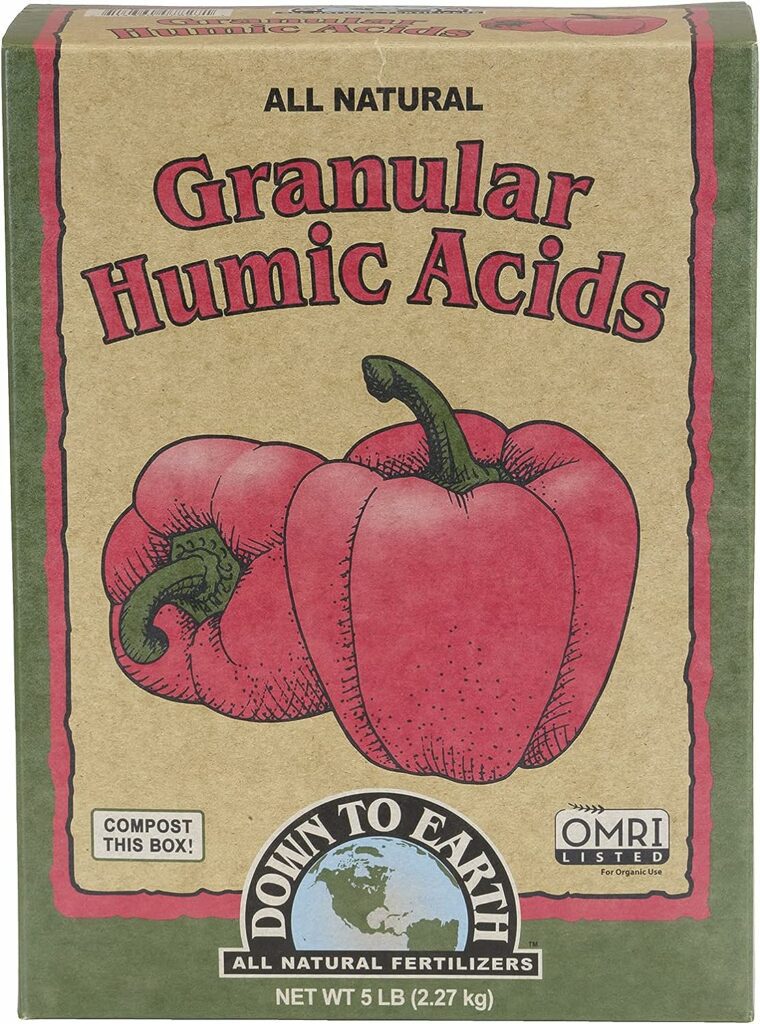
(32) HumiChar
HumiChar is an organic, carbon-based soil amendment containing 50% high-quality humic acid and 50% granulated biochar — Provides the benefit of quickly-available humic acid and the long-term soil building qualities of the biochar that lasts for decades. Use it to improve your soil health, lawn health, plant health, and reduce the use of fertilizers.
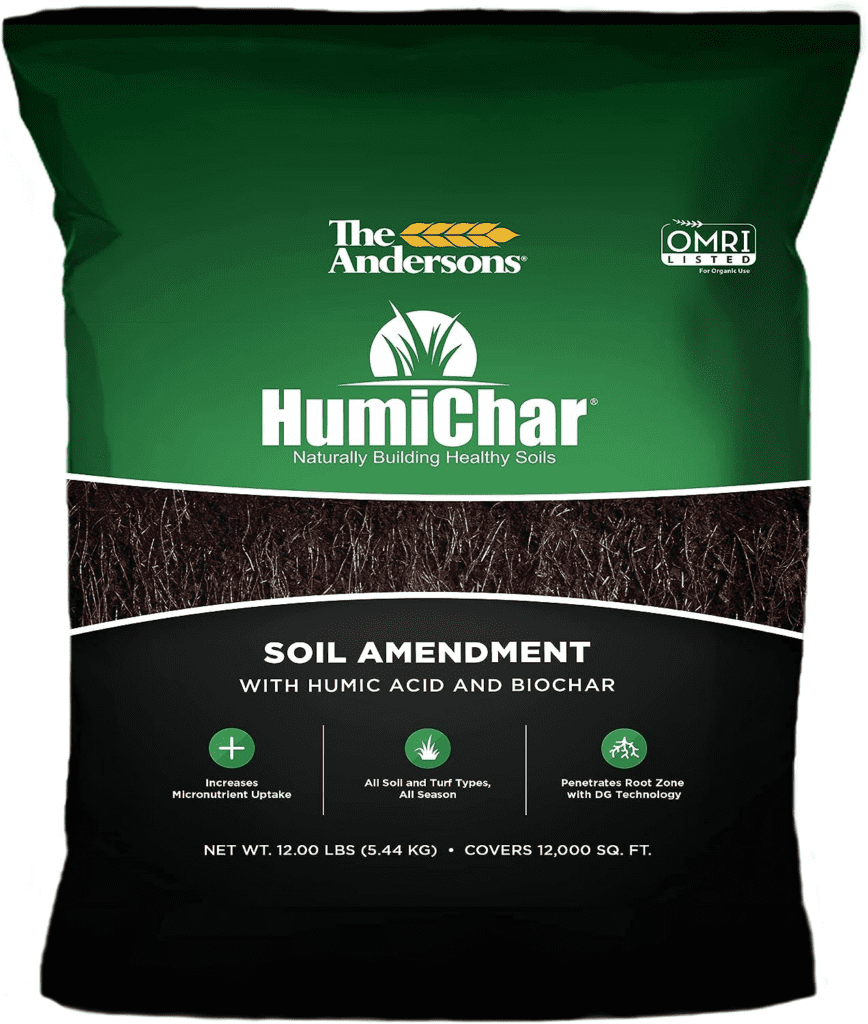
(33) Humus
Humus is a dark, organic material that forms in soil when plant and animal matter decays. The material is called leaf litter and includes leaves, twigs, and other material that plants drop to the ground. When animals die, their remains add to the litter. Over time, all this litter decomposes.
Humus is found in the top few inches of soil. It has a loose, crumbly, and spongy texture. The color of humus is brown or black. Soils full of Humus is rich in nutrients and retains moisture in the soil.
Humus is the Latin word for “earth” or “ground”.
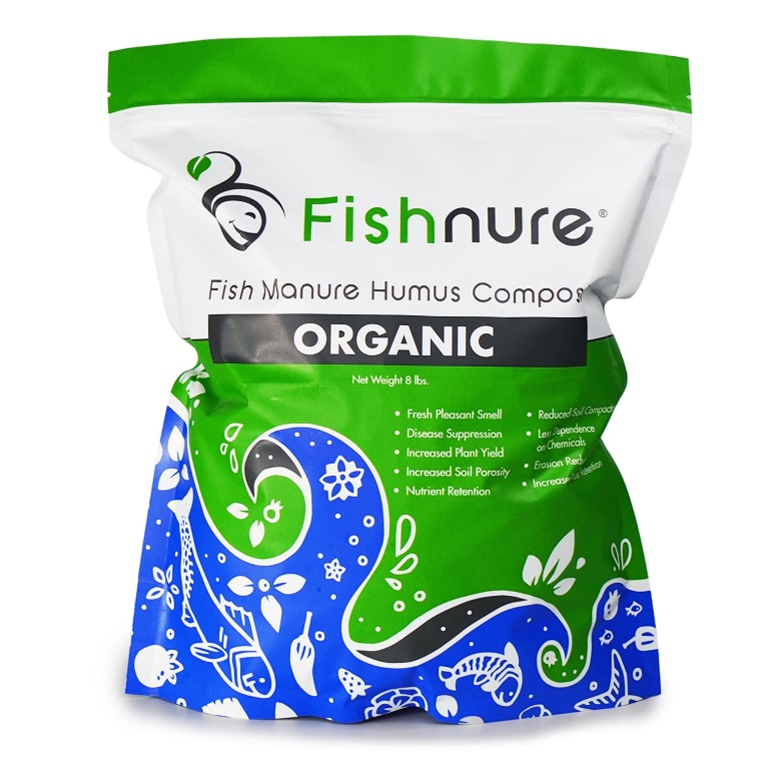
(34) Hydrated Lime
Hydrated Lime quickly raises soil pH. Adjusting the soil to the proper pH helps plants to grow & strengthen by making it easier for plant roots to take up nutrients in the soil. Hydrated Lime helps neutralize soil acidity and “sweetens” the soil. Do not mix with fertilizer before use.
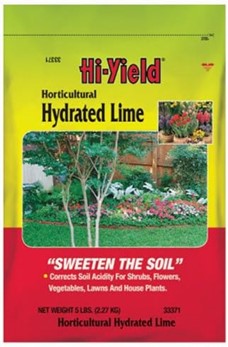
(35) Kelp Meal
Kelp meal is a soil amendment made from dried seaweed. It amends trace minerals, growth hormones, and beneficial microorganisms. This overall enhances plant growth and soil health.
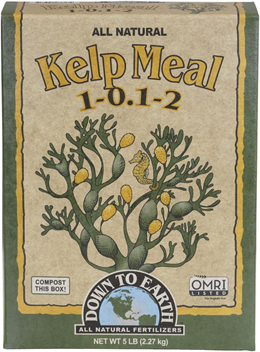
(36) Leaf Mulch
Leaf mulch, or organic mulch in general, provides numerous benefits for your garden. Leaf mulch blocks lights to weed seeds, reduces surface evaporation, insulates the soil from cold weather and fluctuating temperatures, prevents soil erosion and crusting, and adds nutrients to the sol over time improving soil fertility.
(37) Limestone (Lime)
Use lime to raise soil pH levels in acidic soils. It contains calcium and magnesium, which are essential for plant growth. Lime also helps neutralize soil acidity, making nutrients more available to plants and improving overall soil fertility.
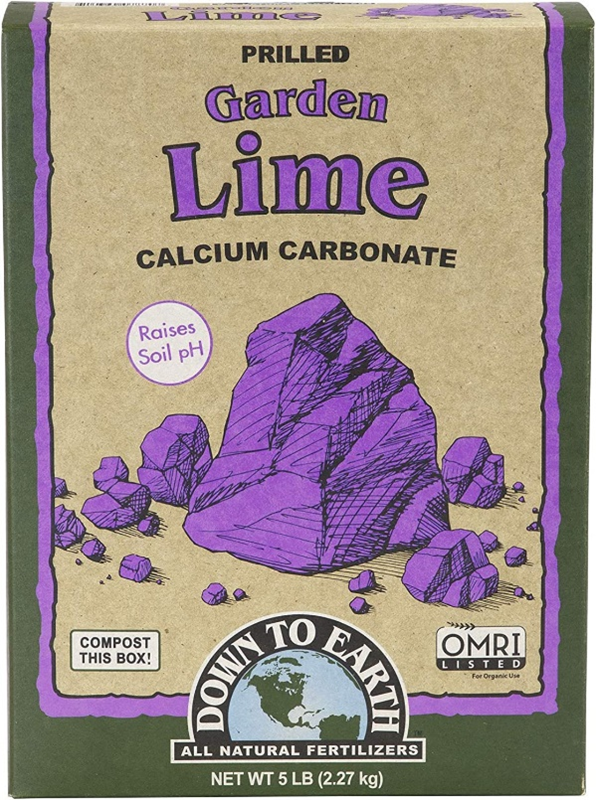
(38) Magnesium Sulfate
Magnesium sulfate, also known as Epsom salt, is a soil amendment that can be used to correct magnesium deficiencies in plants and soil. It can also be used to promote plant growth, increase flowering, and deter pests like slugs and voles.
Magnesium sulfate can be used to prevent magnesium deficiencies before or during planting, or to correct growth problems during the growing season. It can also be used as part of a hydroponic nutrient solution.
Too much magnesium can inhibit the uptake of calcium, and the plant may display symptoms of an excess of salts, such as stunted growth and dark-colored vegetation.
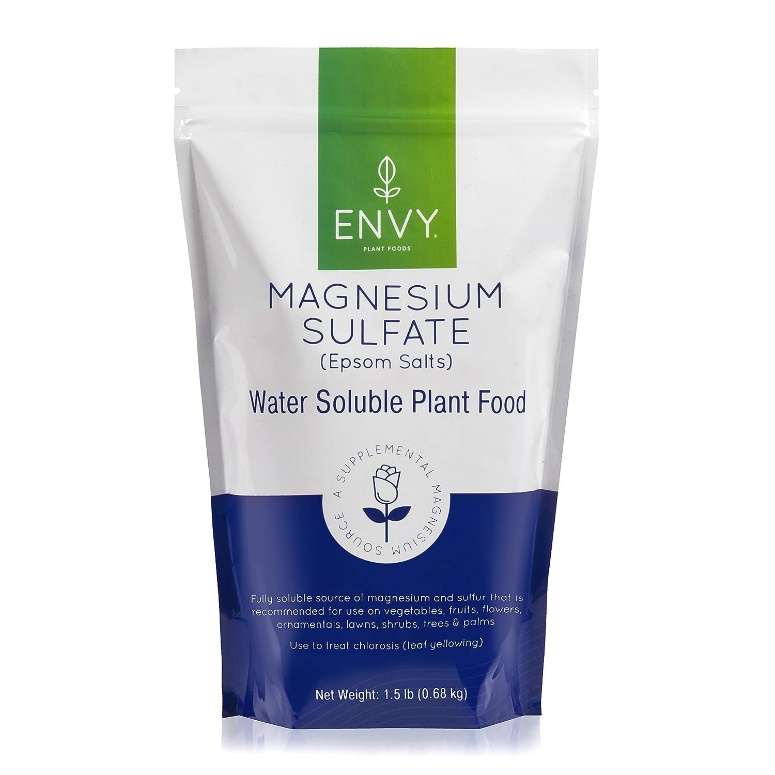
(39) Manure (Composted)
Manure is a soil amendment that is made from animal waste, such as cow, horse, or chicken manure. It is rich in nutrients and can help to improve soil fertility. However, it should be aged or composted before use to avoid burning plants with high nitrogen content.
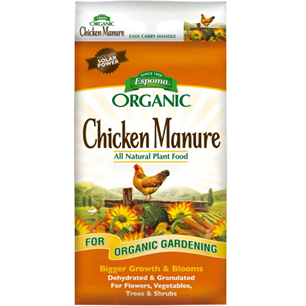
(40) Mushroom Compost
Compost made from mushroom growing medium. Enhances soil structure, adds organic matter, and improves nutrient content.
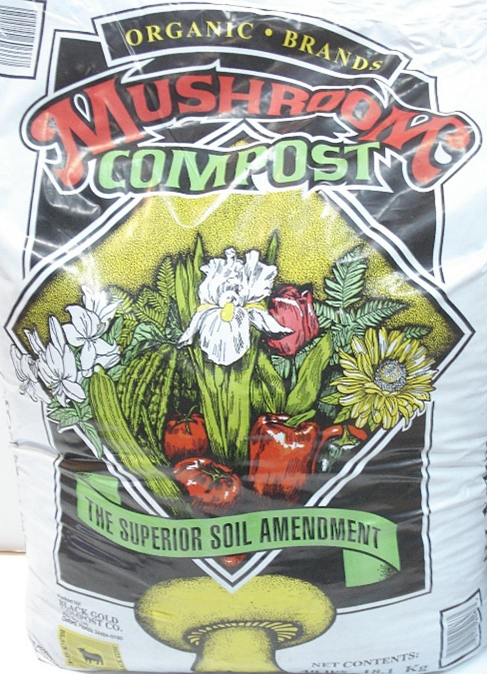
(41) Mycorrhizal Fungi
Mycorrhizal fungi are beneficial fungi that grow in association with plant roots. They have a root-like structure and a network of mycelium that extends into the soil. The mycelium absorbs nutrients and translocate them back to the host plant. Mycorrhizas increase the absorptive area of a plant, acting as extensions to the root system. They also take sugars from plants in exchange for moisture and nutrients gathered from the soil.
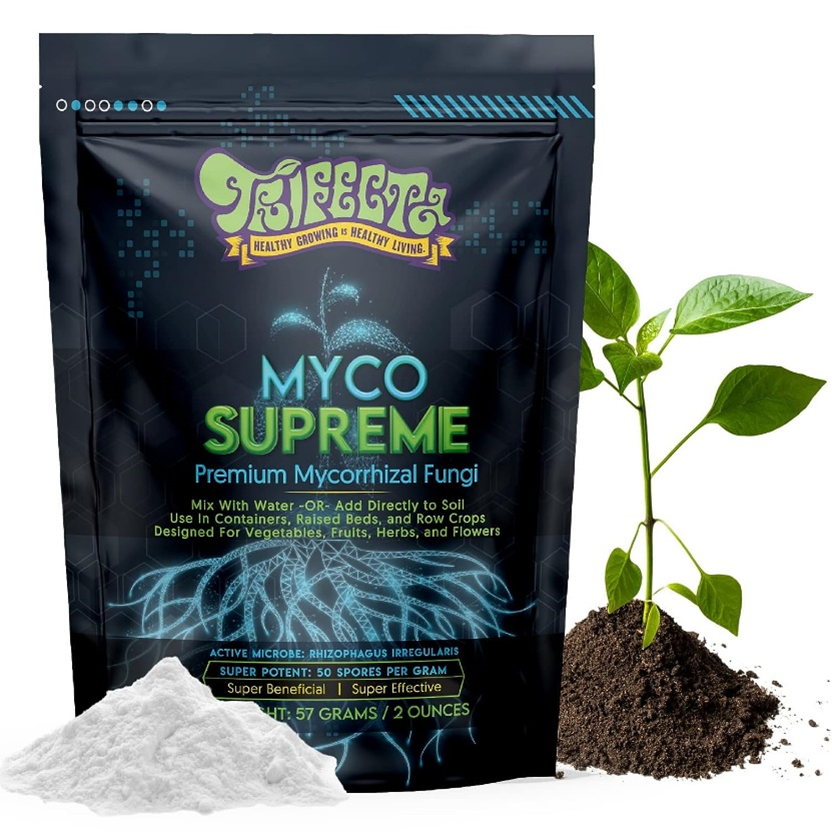
(42) Neem Seed Meal
Neem Seed Meal is a natural fertilizer that is produced from the Indian Neem tree. It is also known as Neem Cake. Neem Seed Meal can be mixed into soil or potting mediums, used as a top dress, or steeped to make a liquid solution. It is an excellent way to strengthen root systems, improve plant immunity, and balance nutrient levels in the soil.
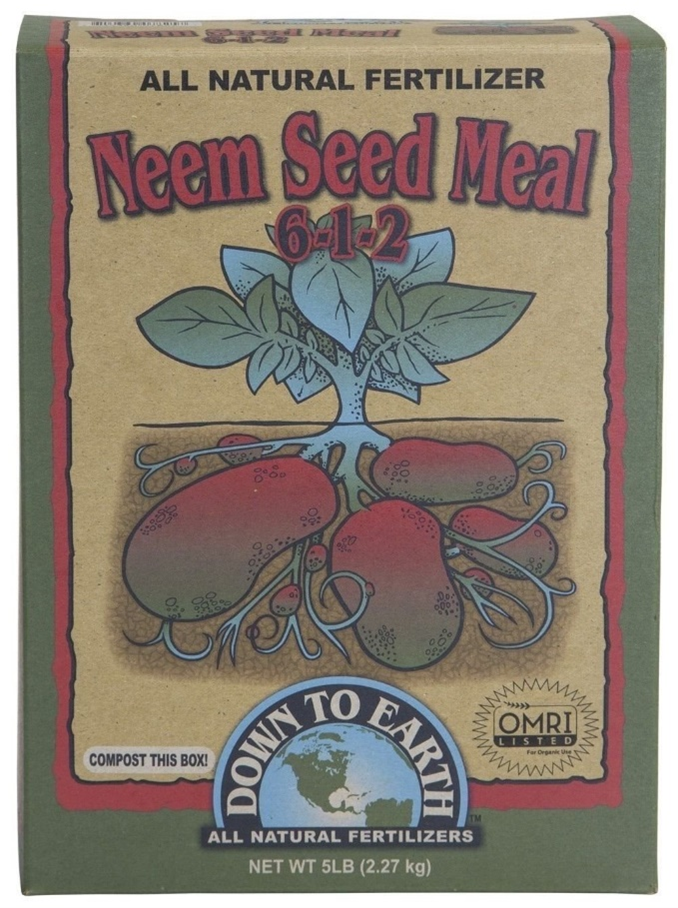
(43) Peanut Meal
Peanut meal is a by-product of the U.S. peanut oil industry. This OMRI Listed meal is the remaining material after all the oil is extracted. Peanut meal typically contains 8 percent total nitrogen (~5.5 percent water insoluble), 1 percent available phosphate, and 2 percent soluble potash.
(44) Perlite
Perlite is a volcanic mineral that improves soil aeration and drainage. It helps prevent soil compaction, allowing roots to access oxygen and nutrients. Perlite is often used in potting mixes to promote healthy root development. It can be a substitute for vermiculite in soil mixes.
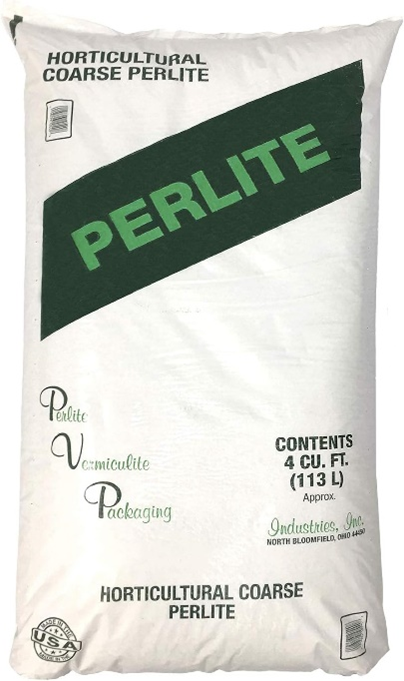
(45) Pine Straw
Pine Straw are acidic but do not have the capacity to lower the soil pH any perceptual amount. As the needles break down, and are incorporated into the soil, decomposing microbes neutralize them. They are a great mulch that does not greatly impact the soil’s pH, even when incorporated into the soil.
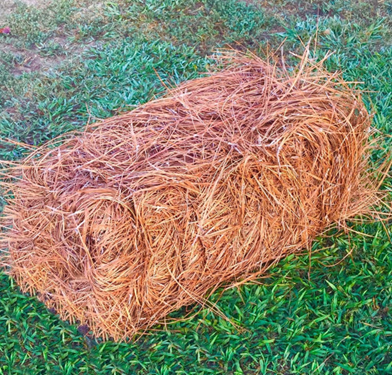
(46) Rice Hulls
Rice hulls are an after-product of hulling rice. They provide aeration, improve drainage, and prevent compaction in the soil. They are particularly useful for container gardening. Be sustainable and use something that would otherwise be disposed of.
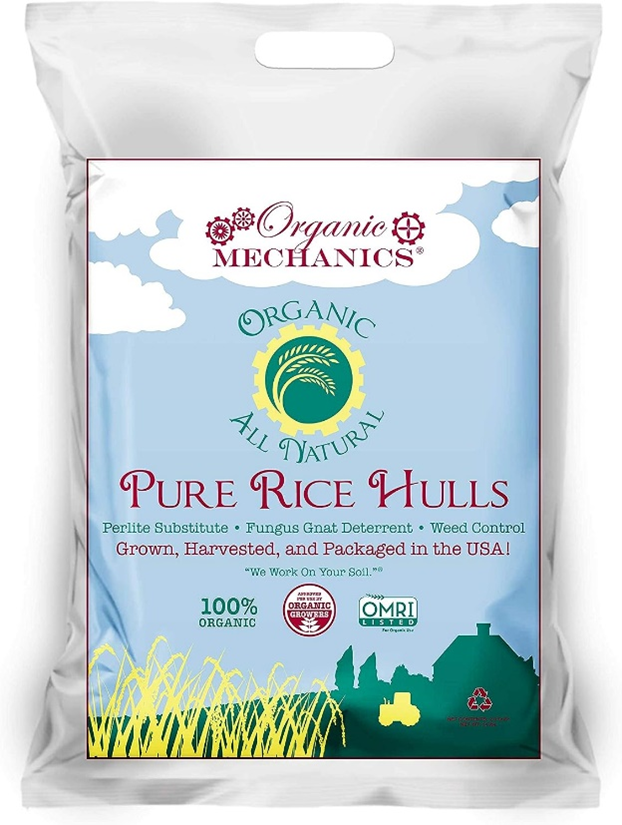
(47) Rock Phosphate
Rock Phosphate is a slow-release phosphorus amendment derived from rock minerals. It improves root development, flowering, and fruiting.
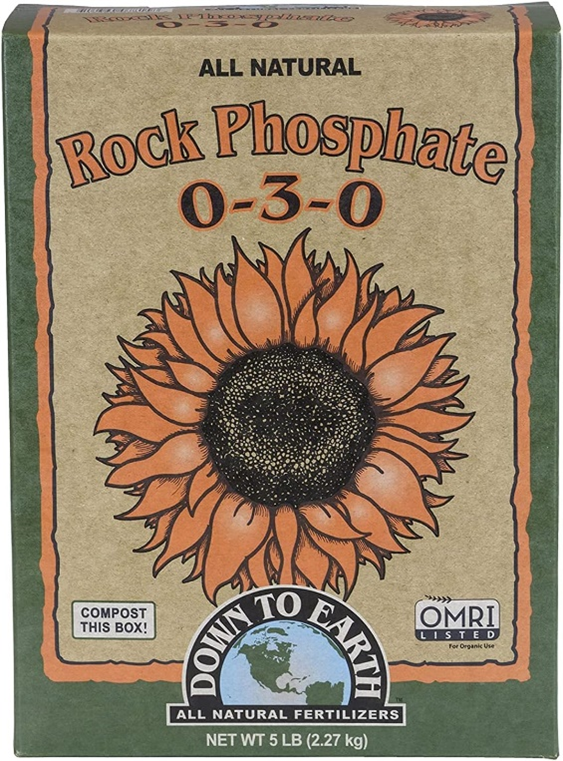
(48) Sand
Add Sand to heavy clay soil to help improve drainage. It allows excess water to move through the soil more easily and prevents waterlogging. However, excessive use of sand can lead to poor nutrient retention and decreased fertility.
(49) Sawdust
Use Sawdust as a soil amendment to build organic matter into soil, especially hard, compacting, and clay-rich soils. It can also increase aeration, water holding capacity, and microbial activity in soil.
Spread sawdust around the base of garden plants to prevent weeds, retain moisture, and keep roots cooler. However, sawdust is not a good source of important plant nutrients such as nitrogen, phosphorus, and potassium. When used properly, sawdust can support plant growth by improving soil.
Sawdust can take months to years to break down into humus.
(50) Seabird Guano
Seabird guano is a natural fertilizer that is high in nitrogen and phosphorus and low in potassium. Use seabird as a soil amendment or applied as a liquid fertilizer. Seabird guano is water soluble, so use it as a tea or foliar spray.
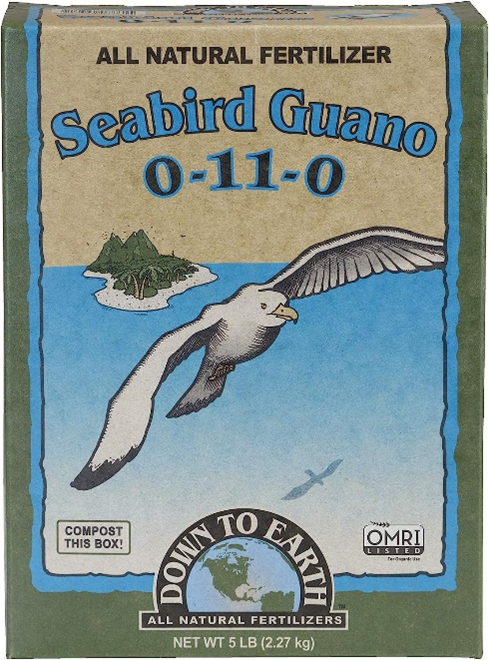
(51) Seaweed Extract (dried)
Seaweed extract is a type of organic bio-fertilizer that is rich in micro and macronutrients, humic acids, and phytohormones. Use seaweed extract to promote bacterial activity in soil sources and increase soil fertility. Seaweed extract can also help plants grow bigger and develop stronger root systems.
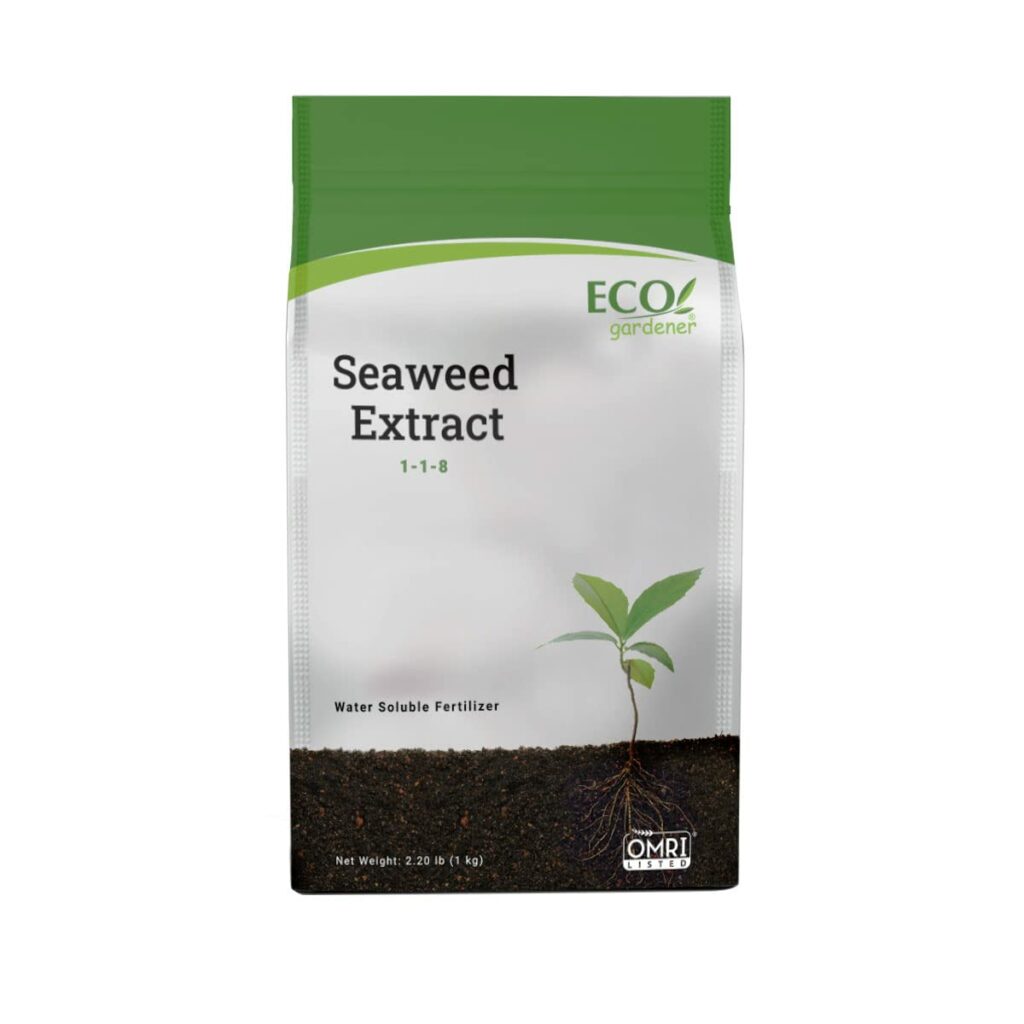
(52) Shrimp Meal
Shrimp meal is an all-purpose fertilizer that is rich in nitrogen, phosphorus, calcium, and chitin. It is a slow-release fertilizer that conditions the soil and protects against pests and disease.
Shrimp meal is a valuable byproduct of the shrimp processing industry and will break down rapidly in the soil to promote vigorous plant growth and development.
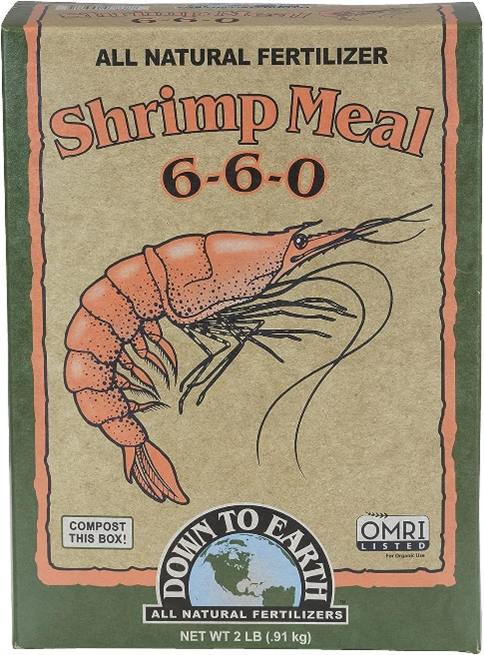
(53) Soybean Meal
Soybean meal is an organic fertilizer that is high in nitrogen, phosphorus, and potassium. It is a slow-release fertilizer that can last in the soil for up to two years. Soybean meal is a good choice for vegetable and flower gardens, lawns, and landscapes.
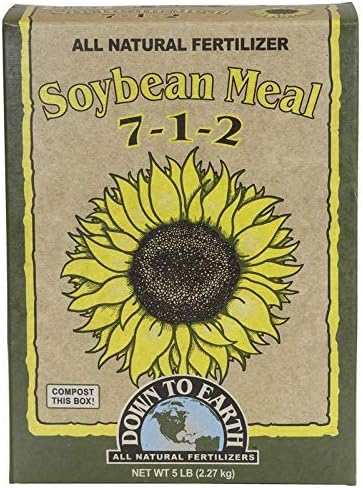
(54) Sphagnum Peat Moss
Sphagnum Peat moss improves soil texture and water-holding capacity. It also helps in retaining nutrients and enhancing root development. Most peat moss has a near neutral pH. An exception is Canadian sphagnum peat moss which has a low pH of 3.0 to 4.5. Use more acidic pH sphagnum peat moss to help acidify soil. Sphagnum peat moss if also commonly used in potting mixes. The downside of using this material is the fact that it is not a renewable resource.
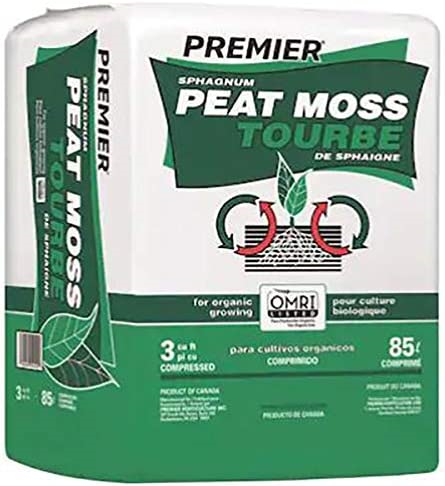
(55) Straw
Use straw as a soil amendment to improve poor, dense, clay, and sandy soils. When mixed into the soil, straw adds bulk and organic matter, which improves the soil structure and makes it more porous.
Straw also helps improve the soil over time. As the straw breaks down, it releases nutrients tht can nourish plants as they grow.
Straw can also help reduce erosion and protect microbes.
It’s primary use though is as a garden mulch in any season.
(56) Sul-Po-Mag (Langbeinite)
Sul-Po-Mag is a brand name for a natural mineral salt called langbeinite. It contains 22% potash, 11% magnesium, and 23% sulfur. Sul-Po-Mag is a good source of potassium, magnesium, and sulfur, which are essential nutrients for plants.
Use Sul-Po-Mag as a fertilizer for sensitive vegetables and fruit crops that require high fertilizer rates. Use it to supplement a plant’s feeding program, as well.
An alternative name for Sul-Po-Mag is K-Mag. It is a soluble, crushed mineral that does not alter soil pH.
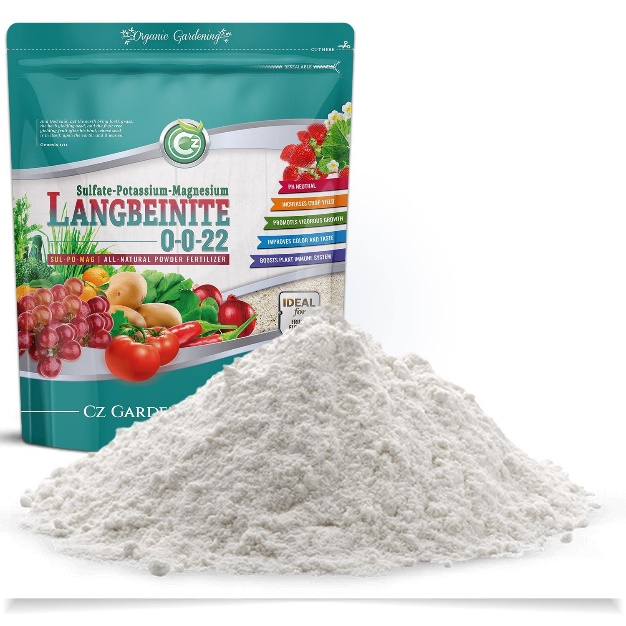
(57) Sulfate of Potash
Sulfate of potash is a fertilizer that contains potassium and sulfur. It is a natural potash mineral that contains 51% soluble potash and 18% sulfur. It also contains trace amounts of calcium and magnesium.
Sulfate of potash is a high-potassium, low-chloride fertilizer that helps plants resist disease and pests, and produce tastier and more attractive produce. It also promotes the development and color of flowers and increases fruit yields.
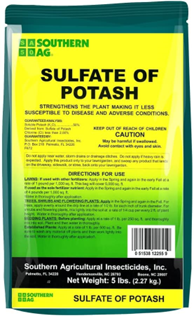
(58) Vermiculite
Vermiculite is a mineral that aids in improving soil drainage and aeration. It helps retain moisture while preventing compaction in the soil. Use Vermiculite in container gardening and seed-starting mixes. The coarse size of vermiculite is preferable.
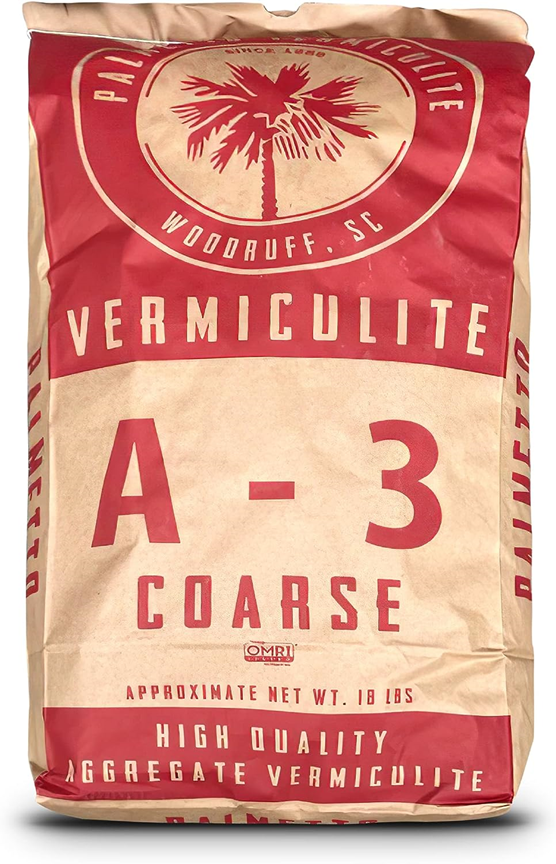
(59) Wood Ash
Calcium makes up about 20% or more of wood ash. That’s important since that’s the primary active ingredient in garden lime. So, if your soil is acidic, amending it with wood ash can raise your soil pH level. You can substitute four cups of wood ash for one pound of agricultural lime. Note that if you soil is already neutral or alkaline, wood ash could raise the pH too high a level.
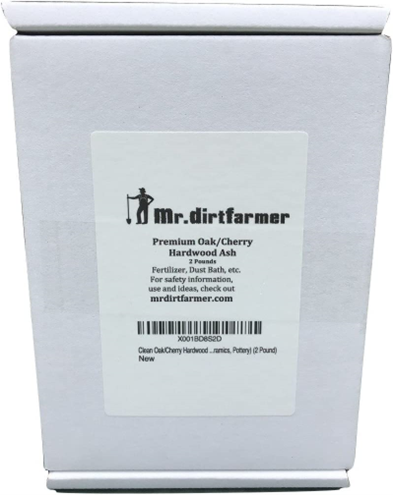
(60) Wood Chips
Utilizing wood chips as mulch will not change your soil’s pH, except a slight increase in acidity localized in the very top of the soil. The slight increase of acidity and a drop in readily available nitrogen due to decomposition of the wood chips would occur if the wood chips are worked into the soil and not used just as a mulch.
(61) Worm Castings
Worm Castings are beneficial to the soil for several reasons including the addition of plant accessible nutrients, beneficial microorganisms, and organic matter. As far as changing the pH of soil, worm casting pH is near neutral with a pH of 7. It will not change your soil’s pH to any significant amount.
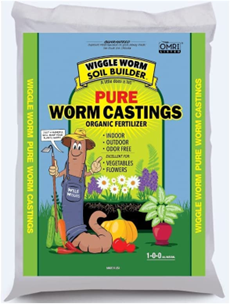
(62) Zeolites
In the natural environment, zeolites were formed at sites of volcanic activity. When a volcano was on an island or in coastal areas, the ejected lava and ash entered the waters where, when mixed with saline seawater, underwent hydrothermal reactions that over thousands of years led to the formation of crystalline solids called zeolites
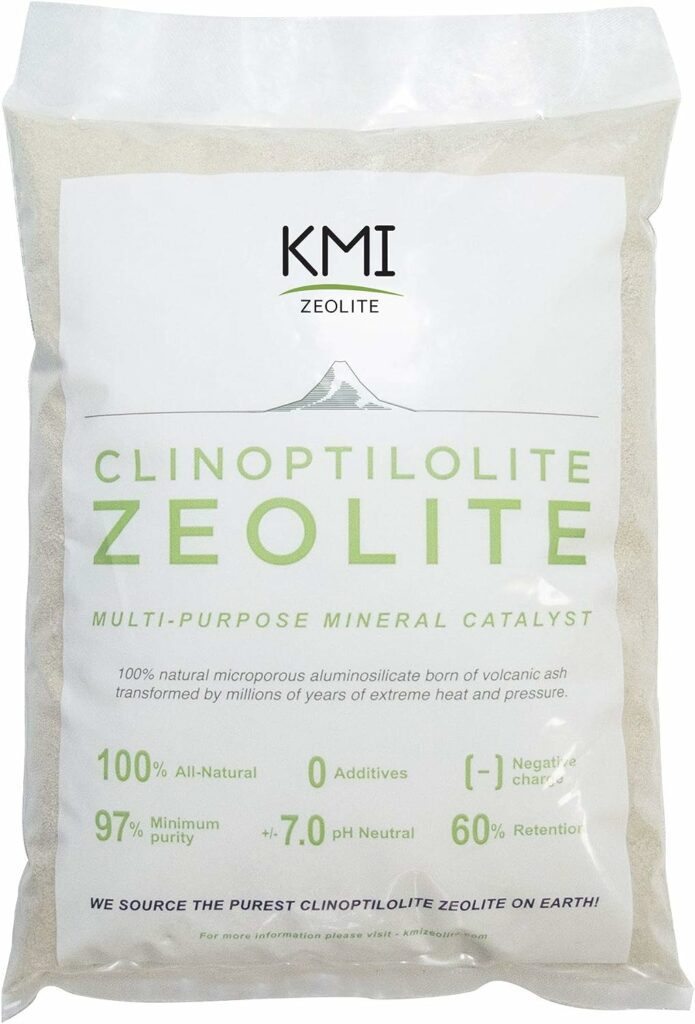
Conclusion
The health of your garden soil is major factor that determines whether you will be able to achieve a bountiful harvest in your garden. Whether starting from scratch on an in-ground, a raised bed, or a container garden, the soil makes the difference.
You will also want to amend your soil after each season, or at least annually, to get your soil health right as the plants that grew have depleted your soil of nutrients and minerals. I’ve covered 62 top dry soil amendments to improve the garden. Take a look at all of these dry soil amendments and apply those will work in your specific garden with specific needs.
So, identify the soil amendments that you need and get your garden soil fertile and healthy.
If you like this content, check out my Complete Guide to Growing Cilantro. You will want to check out my Louisiana Simple Living YouTube channel as well.
Garden On! See you soon on Louisiana Simple Living!

Leave a Reply